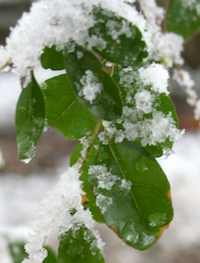Don’t box up those old Christmas tree lights just yet. Along with old blankets, quilts and cardboard boxes, they could be the key to keeping tender plants from freezing this winter.
“With real tender vegetation, add Christmas tree lights underneath their coverings to keep them warm,” said Gary Wade, a University of Georgia Cooperative Extension horticulturist. “But don’t use the new LED Christmas lights. They don’t produce enough heat.”
Wade also uses shop lights under the covering to help keep his plants warm.
The Dos and Don’ts
As temperatures drop into the teens and clouds threaten to drop snow and ice, gardeners are scrambling to keep their plants alive. Wrapping plants in quilts and blankets, topping them with cardboard boxes or caging them with chicken wire filled with dry leaves – “anything that provides insulation” – is what Wade suggests.
Make sure that the bottom of whatever is wrapped around the plant is open to the ground. This will allow heat from the ground to radiate under the covering and warm the plant.
The worst thing plant lovers can do it cover their plants with plastic.
“Lots of people put plastic garbage bags over their plants,” Wade said. “This often causes more damage than it helps.”
Plastic sheeting and bags trap moisture, which can in turn freeze on a plant’s leaves and cause significant damage to the plant. Cloth coverings, on the other hand, absorb moisture and prevent ice build-up on leaves.
Wade also cautions homeowners against trying to use sprinklers to blanket their plants with ice. Creating an ice blanket over plants is a common practice used by commercial strawberry growers, but, in their case, they have enough water volume to continually keep ice forming on the plants. As water freezes, it releases heat, so they maintain a constant spray of water on the plants.
This technique doesn’t work on landscape plants. Homeowners usually can’t supply the volume of water that this technique requires, but more importantly, ice buildup can break branches. It can do more harm than good.
“Covering plants is a lot better,” Wade said.
Container plants
The best way to keep a container plant alive during extremely cold weather is to bring it inside – whether into a home, garage, greenhouse or shed.
If that is not an option, first, push container plants together to decrease heat loss. Then, cover or mulch the plants. Finally, wrap the containers and the plants in burlap or blankets.
After a freeze
Plants may feel the cold the night they freeze, but they won’t show the damage until several days or weeks later.
To determine if plants have been damaged by the cold, wait several days after a freeze. Then, use a knife to peel a small section of the bark back – just to the layer of wood directly under the bark. The plant has been damaged if you see brown or black discoloration.
Cracks in the bark, particularly along the main trunk, are another indication of freeze damage, Wade said.
Damaged leaves are easy to identify because they look black or burnt.
Frozen buds will likely abort from the plant.
Don’t prune right after a freeze. Wait until early spring so you can see what new growth emerges and where it emerges before pruning out damaged wood. For foliage and stem damage, prune several inches below the injured tissue.
For more information on taking care of ornamental plants during cold weather, visit pubs.caes.uga.edu/caespubs/pubcd/C872/C872.htm or contact your local county Cooperative Extension agent at 1-800-ASK-UGA1.

-78201.jpg)






